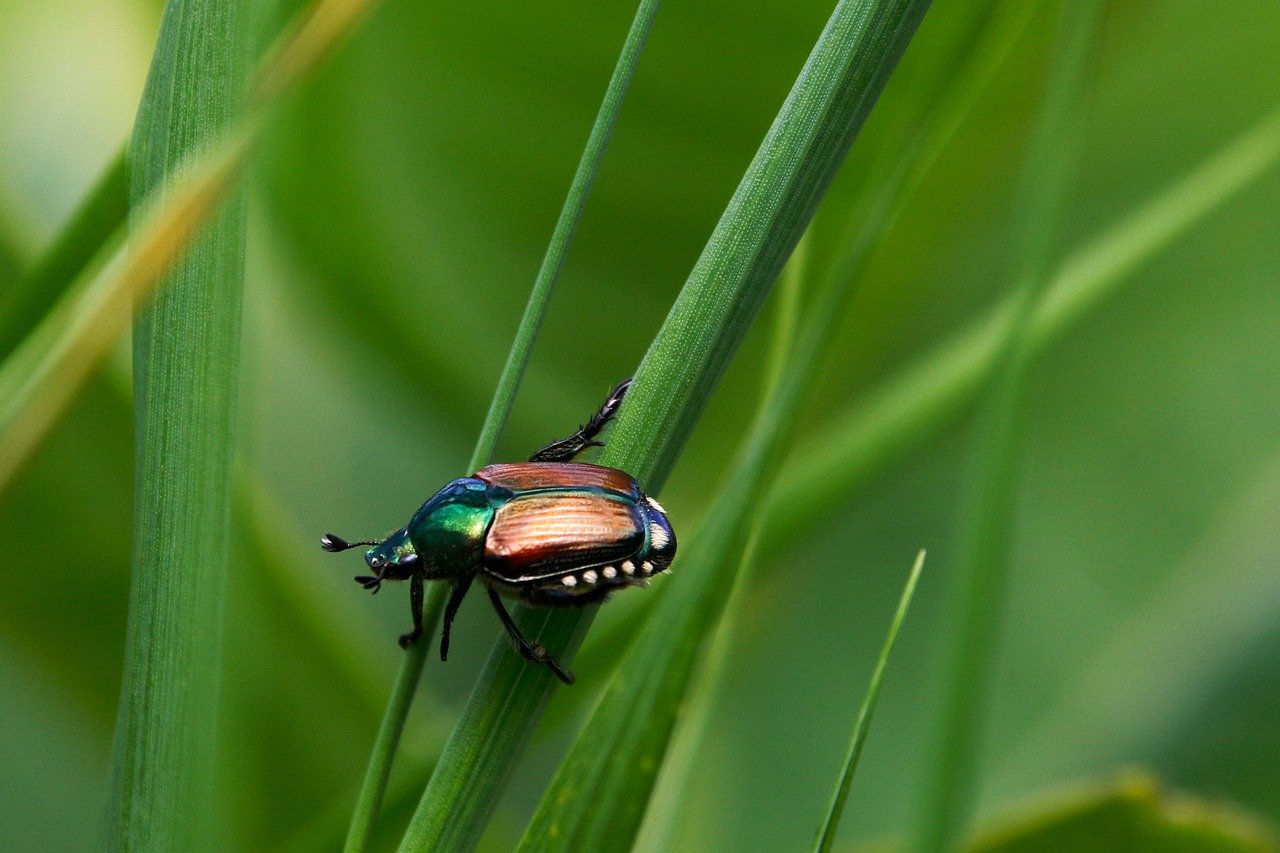
The iridescent gleam of a Japanese beetle can be a gardener’s worst nightmare. These metallic green intruders, with their insatiable appetite for leaves and flowers, can transform a flourishing garden into a skeleton of its former glory. Before you reach for the chemical cavalry, consider a more natural approach to this horticultural war.
This post may have affiliate links. This means that sometimes when you click a link on our site and make a purchase on Amazon, we may earn a small commission at no additional cost to you. We only recommend products we truly believe in, and your support helps keep us running!
Weapon #1: Enlist the Help of Beneficial Bounty Hunters
Nature, in its infinite wisdom, has provided a squadron of allies to combat these leafy foes. Let’s explore some of these beneficial bugs:
- Predatory Wasps: These tiny terrors, with names like “Tiphia popilliavora” and “Tiphia vernalis,” are the ultimate assassins of the Japanese beetle world. They specialize in hunting grubs (the larval stage) in the soil, injecting them with eggs that hatch into ravenous wasp larvae.
- Nematodes: Microscopic, worm-like nematodes are the John Wicks of the soil. Specific strains, like Steinernema scarabaei, actively seek out Japanese beetle grubs, entering their bodies and releasing deadly bacteria.
- Ladybugs and Lacewings: These familiar faces are more than just adorable. They readily devour beetle eggs and young larvae, helping to curb the next generation of invaders.
How to Attract These Beneficials:
- Provide Shelter: Plant a variety of flowering herbs and native plants with hollow stems, like dill, fennel, and bee balm. These serve as cozy havens for these beneficial insects.
- Offer Food Sources: Plant nectar-rich flowers like cosmos, asters, and dandelions to attract adult wasps and ladybugs.
- Minimize Disruption: Avoid using broad-spectrum insecticides, which can harm these beneficial allies along with the target pests.
Weapon #2: Utilize the Power of Plants
Believe it or not, some plants can actually deter these metallic marauders:
- Trap Crops: These botanical kamikazes, like hollyhocks and crabapple trees, attract beetles away from your prized plants. Once the beetles feast on these sacrificial lambs, you can handpick or use traps to eliminate them.
- Repellent Plants: Certain herbs, like tansy, garlic, and rue, emit strong odors that Japanese beetles find distasteful. Strategically planting these herbs around your vulnerable plants can create a natural barrier.
- Beneficial Blooms: Interplanting your garden with marigolds and nasturtiums not only adds a splash of color but can also deter beetles with their unique scent.
NOTE:
The effectiveness of these plants can vary depending on the severity of the infestation and the beetles’ desperation. Experiment with different combinations to find what works best in your garden.
Weapon #3: Outsmart the Beetle with Cunning Traps
Sometimes, a little trickery goes a long way:
- Japanese Beetle Traps: These commercially available Japanese Beetle traps use a lure (often a pheromone) to attract beetles, trapping them in a container where they can’t escape. However, be mindful – these traps can also attract beetles from your neighbors’ yards, so consider placement carefully.
- Homemade Bucket Traps: Fill a brightly colored bucket (yellow is particularly attractive) with a mixture of soapy water. The beetles, drawn to the color, will fall in and drown. This is a low-cost and effective option, but requires regular monitoring and emptying.
A Word of Caution:
While traps can be helpful in capturing adult beetles, they don’t address the root of the problem – the grubs in the soil. Combine traps with other strategies for a more holistic approach.
Weapon #4: Embrace the Power of DIY Solutions
For the crafty gardener, there are a few homemade concoctions that can deter these persistent pests:
- Neem Oil Spray: Extracted from the neem tree, neem oil is a natural insecticide with a bitter taste and odor that repels beetles. Mix a diluted solution according to package instructions and spray directly on your plants. However, be aware that neem oil can harm some beneficial insects, so test it on a small area first.
- Diatomaceous Earth: This all-natural powder, made from fossilized algae, has microscopic sharp edges that dehydrate insects upon contact. Apply a light dusting around the base of your plants, focusing on areas where grubs might enter the soil.
- Garlic Spray: The pungent aroma of garlic can be a natural beetle deterrent. Create a spray by soaking chopped garlic cloves in water for several hours, then strain and dilute before applying to your plants.
NOTE
These DIY solutions may require more frequent application compared to chemical pesticides. However, they are a safer option for your garden ecosystem and beneficial insects.
Weapon #5: Disrupt the Beetle’s Life Cycle
Understanding the Japanese beetle’s life cycle can empower you to disrupt its path to destruction:
- Fall Cleanup: Adult beetles lay eggs in the fall in moist soil. Removing leaves, debris, and weeds from your garden beds can eliminate potential egg-laying sites.
- Tilling Techniques: During the late fall or early spring, consider tilling your soil to a depth of 3-4 inches. This can expose and destroy overwintering grubs.
- Row Covers: Protect young seedlings and vulnerable plants with floating row covers. These lightweight fabrics allow sunlight and water to penetrate while creating a physical barrier against adult beetles.
NOTE:
These practices require consistency and may not completely eliminate the problem, but they can significantly reduce the next generation of beetles.
Conclusion: A Multifaceted Approach to Victory
The battle against Japanese beetles is a marathon, not a sprint. Combining several of these natural strategies will create a more effective and sustainable defense for your garden. Patience, persistence, and a little green ingenuity are the keys to outsmarting these emerald invaders.
